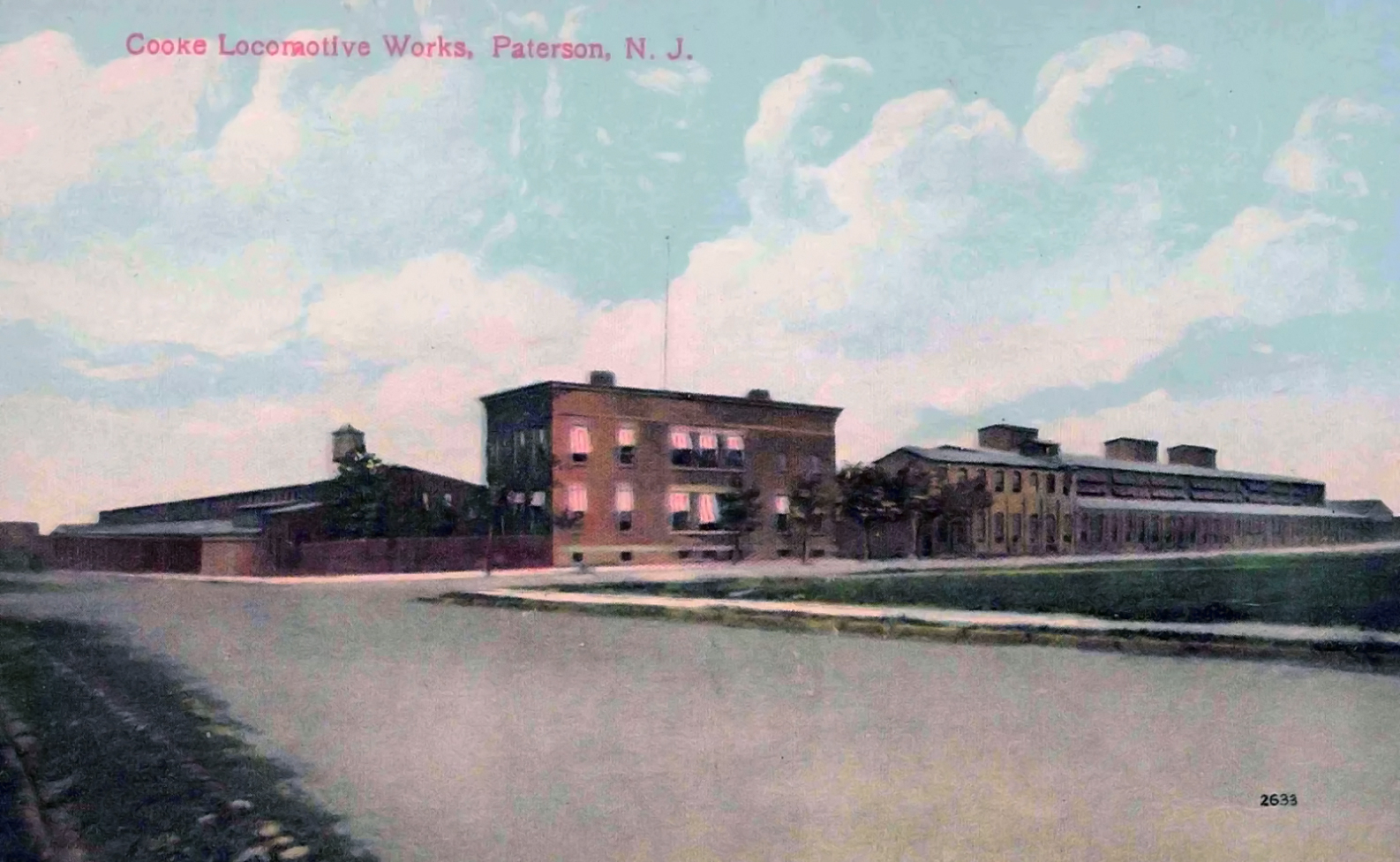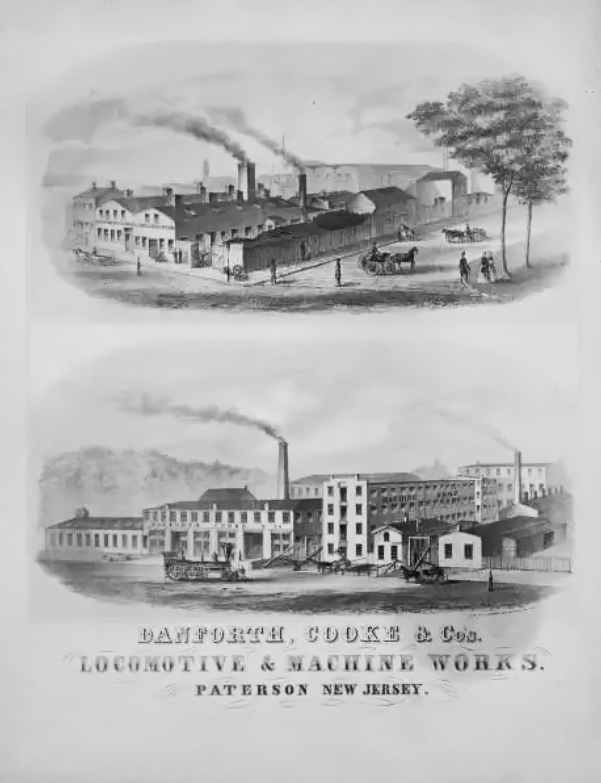Cooke Locomotive and Machine Works
Published: February 19, 2025
By: Adam Burns
The Cooke Locomotive and Machine Works was an influential American locomotive manufacturer that played a vital role in the development of rail transportation in the United States.
Established during the burgeoning era of railroads in the mid-19th century, this company produced thousands of steam locomotives that helped shape the industrial landscape of the nation.
It eventually joined a consortium of other small manufacturers at the turn of the 20th century to form the American Locomotive Company, one of the most successful locomotive builders of all time.
Early Years and Founding
The beginnings of Cooke Locomotive and Machine Works can be traced back to 1852 when it was initially founded as Danforth, Cooke & Company in Paterson, New Jersey. This period marked the dawn of the railroad era in America, characterized by rapid growth and an insatiable demand for efficient rail transport.
Paterson itself was a hub for manufacturing, benefiting from proximity to the Passaic River, which provided a reliable source of water power essential for industrial operations.
The company was formed by John Cooke, a former superintendent at Rogers Locomotive and Machine Works and son-in-law of William Swinburne from Swinburne, Smith & Company, along with Charles Danforth, a former resident of Montreal. Originally named Danforth, Cooke, & Company, the enterprise specialized in the production of steam locomotives and cotton machinery.
In the early years, the factory focused on machinery production before transitioning into locomotive manufacturing. By 1854, two years after its establishment, the company received its first locomotive order, setting the stage for what would become a century-long operation in locomotive production.
In 1865, the company was rebranded as the Danforth Locomotive & Machine Company, with Charles Danforth serving as president until 1871.
Growth and Expansion
Throughout the Civil War (1861-1865), the demand for rail transport increased markedly, as the railroad became crucial for moving troops and supplies across great distances. Cooke Locomotive and Machine Works capitalized on this demand, ramping up production and significantly expanding its operations to keep up with orders. Their locomotives were known for their reliability and robust design, securing Cooke a solid reputation in the industry.
Following the Civil War, the United States entered a period of rapid industrial growth and westward expansion. Railroads were at the forefront of this transformation, requiring a continuous supply of locomotives.
By the 1870s, Cooke was producing a wide range of steam locomotives in various configurations, meeting the diverse needs of different railroad companies. Their models included both passenger and freight locomotives, which were distributed across North America.
The Golden Age
The late 19th and early 20th centuries are often referred to as the "Golden Age of Railroads." During this time, railroads became the backbone of American transportation and commerce, facilitating the movement of goods and people across vast distances.
Cooke Locomotive was instrumental in this development, contributing significantly to the manufacture of the locomotives that powered these trains. By this period, the company had transitioned into the full-time manufacturing of steam locomotives, moving away from its earlier diversified production line.
The factory employed hundreds of skilled workers and engineers who were pivotal in innovating and improving locomotive design and efficiency.
Cooke produced a range of locomotives, including the popular "American" type 4-4-0, which was widely used on railroads across the United States. Their steam engines were known for their quality construction and adherence to the latest engineering practices of the time, making them a preferred choice among railroad operators.
Final Years
Following Danforth's death in 1875, John Cooke assumed the presidency until his own passing in 1882. Subsequently, Cooke's sons—John, Frederick, and Charles—restructured the company into the Cooke Locomotive and Machine Works.
In 1901, Cooke merged with several other locomotive manufacturers to form the American Locomotive Company (Alco), a move intended to consolidate resources and strengthen its market position against competitors like Baldwin Locomotive Works and Lima Locomotive Works.
Consequently, Cooke's facility was re-designated as the Alco-Cooke Works, where locomotive production persisted until 1926. Over its operational history from 1852 to 1901, Cooke constructed approximately 2,600 locomotives, including such notable models as the "C. P. Huntington" and the Western & Atlantic Railroad's "Texas".
Legacy
Even as a part of Alco, the legacy of Cooke continued within the larger entity, contributing to the production of various notable steam locomotives and later transitioning into diesel locomotive manufacturing.
Cooke Locomotive left an indelible mark on the history of American transportation. Through its expert craftsmanship and innovative designs, the company produced machines that powered countless trains across the United States, significantly influencing both the economy and the society of its time.
Although the plant eventually ceased operations, its legacy endured through its contributions to the industrial growth and subsequent rise of the United States as a global economic power. The locomotives produced by Cooke are remembered for their engineering significance and are celebrated by rail enthusiasts and historians alike.
Many of its locomotives have been preserved in railroad museums across the country, standing as testaments to the company’s impact on the development of rail transportation. Cooke’s commitment to quality and innovation serves as a reminder of the pivotal role played by manufacturing and engineering in the progress of American industry.
In recounting the history of Cooke Locomotive and Machine Works, we see a story of industrial growth, adaptation, and legacy—a narrative tied intricately with the rise of railroads and the transformation of the United States into an industrial powerhouse.
Recent Articles
-
Rogers Locomotive and Machine Works
Feb 21, 25 12:30 AM
The Rogers Locomotive and Machine Works was a major U.S. manufacturer throughout the 19th century, specializing in locomotives and heavy machinery. It merged with Alco in 1905. -
Norris Locomotive Works: Major 19th Century Builder
Feb 21, 25 12:24 AM
The Norris Locomotive Works was the preeminent locomotive builder through the mid-19th century until the family owned business voluntarily ended prodution in 1866. -
Peoria and Eastern Railway
Feb 20, 25 11:24 PM
The Peoria and Eastern Railway was a notable subsidiary of the New York Central with a heritage tracing back to the 1830s. Much of the system was abandoned in Illinois by the 1990s.




